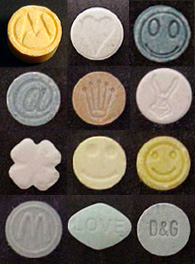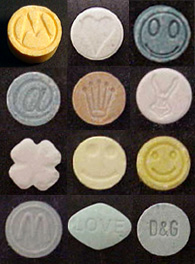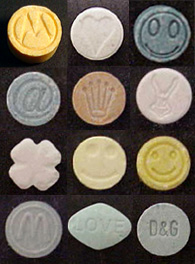More and more individuals are experimenting with recreational drugs. This is happening not only in other countries but also here in Singapore. Anecdotal information indicates that such drugs are used by persons from all strata of society, all occupations and age groups. Of these "new generation" recreational drugs the most common is ecstasy or ecstacy - also called E, X, candy. Its chemical name is methylenedioxymethamphetamine or MDMA.

Ecstasy is usually sold as tablets and sometimes as capsules. The photo above depict few of the many different 'designs' available.
In 1985 the DEA classified it as a schedule 1 drug - which made it an illegal substance. Its popularity really took off in the late 1980s and 1990s as a party drug among ravers - initially in the UK and USA but now all over the world. Its consumption has now reached pandemic proportions.
With this in mind we think that you should know a little more about the effects of ecstasy on your mind and body. This is a only summary of what is known. It does not attempt to be a comprehensive or complete dissertation, and unfortunately not quite enough is known of the drug as little research has been or is being conducted because it is an illegal substance almost everywhere in the world.
Ecstasy is usually sold as tablets and sometimes as capsules. In addition to being swallowed it can be snorted, smoked or injected. The effects after swallowing take 30 - 45 minutes to be felt, they last about 6 - 8 hours.
Following ingestion the objective effects include - dilated pupils, slightly increased heartbeat, blood pressure and temperature, increased urine production, a need to defecate, jaw clenching and tooth grinding, jerky eye movements or nystagmus, and rolling of the eyes sometimes to the back of the head.
The subjective effects of MDMA include - a feeling of satiety, a feeling of an enhanced capacity, that one can handle whatever's coming your way, a feeling of enhanced self-esteem and euphoria, a feeling of increased self worth, of self love and self acceptance.
The terms entactogenesis and empathogenesis are often used to describe MDMA. The former is a feeling that everything all is right and good with the world. People on MDMA often describe feeling "at peace" or experiencing a generalized "happy" feeling.
Empathogenesis is a feeling of emotional closeness to others coupled with a breakdown of personal communication barriers, those on MDMA report feeling much more at ease talking to others and that any hangups that one may have with regard to "opening up" to others may be reduced or even eliminated entirely. There is an increased kinesthetic awareness or body awareness in response to MDMA, the focus is shifted more towards posture, deep breathing, and many people find touch and movement in general to be more pleasurable. This is possibly why so many people enjoy dancing, being physical and intimate when taking MDMA. Unfortunately some men have difficulty achieving and maintaining erections, and achieving ejaculation under the influence of MDMA.

Ecstasy is usually sold as tablets and sometimes as capsules. The photo above depict few of the many different 'designs' available.
On the other hand excessive intake of water together with retention of water in the later phase may lead to fluid-electrolyte imbalance which may cause seizures and increased fluid in the brain. MDMA's effect on the liver is not well documented and hepatitis is rare. There have not been many instances of MDMA-related deaths since those reported in the 1990s. Although this does not mean that it is a safe drug, it does compare interestingly with the numbers of deaths related to alcohol consumption.
Among the psychiatric effects which have been reported are - acute anxiety reactions, acute stress reactions, insomnia and nightmares, and depression a few days after use - popularly known as crashing or terrible Tuesdays. The latter effect and the commonly observed loss of effect or tolerance of increasing the intake of ecstasy tablets is believed to be the result of serotonin depletion in the brain.
There is also concern about long-term neural damage leading to memory loss, though this has yet to be proven. As for MDMA causing Parkinson's disease, draining the cerebrospinal fluid, and its use as a date rape drug - there does not seem to be any evidence for these.
The street available ecstasy tablets are never pure and are often mixed (or cut) with other drugs and adulterants - these may include other forms of amphetamines that can make the tablet "speedy", cough suppressants and ketamine that can cause drowsiness and disprientation, and so on. Therefore you need to be extra wary of the potential adverse effects of these contaminants and diluents.

Ecstasy is usually sold as tablets and sometimes as capsules. The photo above depict few of the many different 'designs' available.
BE WARNED THAT ECSTASY AND OTHER RECREATIONAL DRUGS ARE ILLEGAL IN SINGAPORE
The punishments for MDMA are:
- possession/consumption - $20,000 fine or 10 years imprisonment or BOTH (less than10 grams)
- trafficking - 5 - 20 years imprisonment, 5 - 15 strokes (presumed to be trafficking if caught with more than 10 grams)
- import - 5 - 30 years imprisonment, 5 - 15 strokes
- manufacture - 10 - 30 years imprisonment, 5 - 15 strokes
The punishments for Methamphetamine (ice or yaba) are -
- possession/consumption - $20,000 fine or 10 years imprisonment or BOTH (less than 25 grams)
- trafficking - 20-30 years imprisonment, 15 strokes (167-250 grams), death (more than
250 grams) (presumed to be trafficking if caught with more than 25 grams)
- import - 20-30 years imprisonment, 5-15 strokes (167-250 grams), death (more than 250 grams)
- manufacture- death
The punishments for Ketamine are -
- possession/consumption - $20,000 fine or 10 years imprisonment or BOTH
- trafficking - 3-20 years imprisonment, 3-10 strokes (no presumption clause)
- import - 10-30 years imprisonment, 5-15 strokes
- manufacture - 5-30 years imprisonment, 5-15 strokes
Presumption Clause (in brackets) is the specified amount of drugs that if the accused is caught with, is presumed to be trafficking.
There is no death sentence for Ketamine and MDMA in Singapore but Malaysia may impose a death sentence for MDMA.
A new provision has been made in the law to treat consumption of drugs outside Singapore by a citizen or permanent resident as if the offence took place in Singapore.
Before this provision, offenders were able to defend themselves by claiming that they had consumed the drugs overseas. With the amendment, a Singapore Citizen or PR whose urine is tested positive for controlled drugs cannot claim consumption overseas as a defence.
Editor's note: Fridae does not advocate the use of illegal substances. The legal information provided provided is for reference purposes only and recommends that you consult a legal practitioner in every case.
